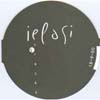 The "5 Tracks" CDR, published in a tiny edition of 100 copies in abeautiful silver-on-black circular sleeve, documents a solo guitar andelectronics concert by improvising guitarist Giuseppe Ielasi in Athens,Greece. Ielasi's improvisations do not contain many typicallyinstrumental gestures; every track sounds like a composed piece of tapemusic, with careful attention paid to the stereo field and to suddenshifts in dynamics and texture. Only a few times do we hear arecognizable volume pedal or a hand rubbing some glass on a guitarstring. For the most part, the level of detail and patience here arethe kind most often found in meticulous studio creations. The highpoint for me is the fourth track, a lengthy piece that starts as hightones and feedback and very slowly (VERY slowly!) adds percussiveelements and crackling synthesizer; the sense of assured calm thatpervades every piece is rare, and just wonderful. There are certainlyaffinities between "5 Tracks" and Kevin Drumm's seminal "Guitar" CD,but I don't think any improviser with an interest in electronic musicwasn't inspired in some way after that album came out.
The "5 Tracks" CDR, published in a tiny edition of 100 copies in abeautiful silver-on-black circular sleeve, documents a solo guitar andelectronics concert by improvising guitarist Giuseppe Ielasi in Athens,Greece. Ielasi's improvisations do not contain many typicallyinstrumental gestures; every track sounds like a composed piece of tapemusic, with careful attention paid to the stereo field and to suddenshifts in dynamics and texture. Only a few times do we hear arecognizable volume pedal or a hand rubbing some glass on a guitarstring. For the most part, the level of detail and patience here arethe kind most often found in meticulous studio creations. The highpoint for me is the fourth track, a lengthy piece that starts as hightones and feedback and very slowly (VERY slowly!) adds percussiveelements and crackling synthesizer; the sense of assured calm thatpervades every piece is rare, and just wonderful. There are certainlyaffinities between "5 Tracks" and Kevin Drumm's seminal "Guitar" CD,but I don't think any improviser with an interest in electronic musicwasn't inspired in some way after that album came out.  Recorded after "5 Tracks', the "Right After" CD does not appear tocontain any guitar at all (at least, not according to the credits).Ielasi's partner on this album is Domenico Sciajno, formerly a bassistand currently one of the most musical and interesting of allimprovising laptop players. Sciajno's computer and Ielasi's electronics(a tableful of gadgets, I imagine) are integrated here into a seamlesssingle voice. I can only assume that the music is improvised due to thehistory of the publisher, Erstwhile Records, but if I had no suchbackground I might not guess as much. If "5 Tracks" only occasionallybelies its uneditted live and improvised nature, "Right After" does notat all. The high sine tones are out in force right from the start,which can be either exhilirating or annoying, depending on yourpatience for such things. The second half turns somber, with calm quietprevailing over the jarring cuts that open the disc. Much moreaggressive and strange than Ielasi's other recordings, "Right After" isalso one of the very best and most cohesive releases on the Erstwhilelabel. More info at www.anet.gr/absurd and www.erstwhile.com.
Recorded after "5 Tracks', the "Right After" CD does not appear tocontain any guitar at all (at least, not according to the credits).Ielasi's partner on this album is Domenico Sciajno, formerly a bassistand currently one of the most musical and interesting of allimprovising laptop players. Sciajno's computer and Ielasi's electronics(a tableful of gadgets, I imagine) are integrated here into a seamlesssingle voice. I can only assume that the music is improvised due to thehistory of the publisher, Erstwhile Records, but if I had no suchbackground I might not guess as much. If "5 Tracks" only occasionallybelies its uneditted live and improvised nature, "Right After" does notat all. The high sine tones are out in force right from the start,which can be either exhilirating or annoying, depending on yourpatience for such things. The second half turns somber, with calm quietprevailing over the jarring cuts that open the disc. Much moreaggressive and strange than Ielasi's other recordings, "Right After" isalso one of the very best and most cohesive releases on the Erstwhilelabel. More info at www.anet.gr/absurd and www.erstwhile.com.samples:
 A very different improvising group from Italy is the strangelypunctuated tu m'. There is virtually no information given on thepackage of tu m's debut CD, but it sure sounds like a laptop to me(that telltale digital high-pitched whine is unmistakable). The groupmoves carefully through six relatively beat-oriented improvisations.The pieces develop slowly and deliberately, with loops rising up andfading out, sine tones entering steadily and cutting out, muted beatstaking a place somewhere in the background and thump thump thumpingalong. Though the music is improvised, it sounds more similar to theabstract Mille Plateaux or Ritornell bands (Neina springs immediatelyto mind) than to what one might think of as "improv". The recordingquality is muddy at times, especially when tu m' brings out the heavybass, so many of the digital details are lost in an undifferentiatedmurk. This could have benefitted from a cleaner production, but theideas still come across. More info at www.cut.fm. -
A very different improvising group from Italy is the strangelypunctuated tu m'. There is virtually no information given on thepackage of tu m's debut CD, but it sure sounds like a laptop to me(that telltale digital high-pitched whine is unmistakable). The groupmoves carefully through six relatively beat-oriented improvisations.The pieces develop slowly and deliberately, with loops rising up andfading out, sine tones entering steadily and cutting out, muted beatstaking a place somewhere in the background and thump thump thumpingalong. Though the music is improvised, it sounds more similar to theabstract Mille Plateaux or Ritornell bands (Neina springs immediatelyto mind) than to what one might think of as "improv". The recordingquality is muddy at times, especially when tu m' brings out the heavybass, so many of the digital details are lost in an undifferentiatedmurk. This could have benefitted from a cleaner production, but theideas still come across. More info at www.cut.fm. -
samples:


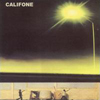 Raised form the semi-ashes of Red Red Meat, Califone started as a soloproject of sorts for that group's Tim Rutili. Eventaully, however, hestarted to bring other people in to play, adding dimension and flavorto the sound, and, eventually, two of the other three members of RedRed Meat, Ben Massarella and Brian Deck. After the release of theircohesive and coherent debut LP "Roomsound" last year on Rutili andMassarella's own Perishable imprint, this year Califone reissues theirfirst self-titled EPs on Flydaddy and Road Cone on Perishable, addingtwo tracks and an official title. "Good Weather" is a view into theCalifone of before, and having heard "Roomsound," it's a great lookinto how jaunting and disparate their sound was early on. Yes, there isclearly a Bowie influence, as well as rural mountain geetar-pickin'.But work it all together with some driving percussion, samples andpiano here and there, and change direction on virtually every track,and what you get takes on a life of its own. You can almost hear aconscious shift between tracks 1-7 and 8-12, where the productionvalues went up, the vocal harmonies move to the front seat, and theinstrumentation is more varied. It's a fascinating listen, evolution ofsound-wise. Of the two bonus tracks, one is a remix of the earliertrack "To Hush a Sick Transmission" sans vocals, and the other is thebest Califone track you've never heard, as it's never been heard untilnow. All in all, a great reissue that shows the early potential of thisensemble considering where they are now.
Raised form the semi-ashes of Red Red Meat, Califone started as a soloproject of sorts for that group's Tim Rutili. Eventaully, however, hestarted to bring other people in to play, adding dimension and flavorto the sound, and, eventually, two of the other three members of RedRed Meat, Ben Massarella and Brian Deck. After the release of theircohesive and coherent debut LP "Roomsound" last year on Rutili andMassarella's own Perishable imprint, this year Califone reissues theirfirst self-titled EPs on Flydaddy and Road Cone on Perishable, addingtwo tracks and an official title. "Good Weather" is a view into theCalifone of before, and having heard "Roomsound," it's a great lookinto how jaunting and disparate their sound was early on. Yes, there isclearly a Bowie influence, as well as rural mountain geetar-pickin'.But work it all together with some driving percussion, samples andpiano here and there, and change direction on virtually every track,and what you get takes on a life of its own. You can almost hear aconscious shift between tracks 1-7 and 8-12, where the productionvalues went up, the vocal harmonies move to the front seat, and theinstrumentation is more varied. It's a fascinating listen, evolution ofsound-wise. Of the two bonus tracks, one is a remix of the earliertrack "To Hush a Sick Transmission" sans vocals, and the other is thebest Califone track you've never heard, as it's never been heard untilnow. All in all, a great reissue that shows the early potential of thisensemble considering where they are now. 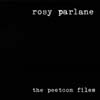 These two are the latest 7" singles in a series initiated by Tonschachtto showcase different strategies of contemporary—not necessarilyelectronic experimental—music. The design is the same as the previousreleases: a white typewriter font on black and vice versa on the infosheet enclosed. Nothing shall distract the listeners attention fromlistening itself. No. 009 features Auckland, New Zealand resident RosyParlane with "Kees.1" and "Kees.2". Side one sets a reduced breakbeatagainst an approaching intense swarm of electronic drones. On theflipside, "Kees.2" continues with an almost orchestral drone fadinginto distraction. Carefully selected sounds are introduced at first,while more sounds are seemingly randomly brought in, step by step,until a new structure evolves. As soon as the piece has completelymutated into something different, it stops. At first both pieces seemto be a bit short but each get to a point which gains and rewards yourattention without having to wait a full CD length for it.
These two are the latest 7" singles in a series initiated by Tonschachtto showcase different strategies of contemporary—not necessarilyelectronic experimental—music. The design is the same as the previousreleases: a white typewriter font on black and vice versa on the infosheet enclosed. Nothing shall distract the listeners attention fromlistening itself. No. 009 features Auckland, New Zealand resident RosyParlane with "Kees.1" and "Kees.2". Side one sets a reduced breakbeatagainst an approaching intense swarm of electronic drones. On theflipside, "Kees.2" continues with an almost orchestral drone fadinginto distraction. Carefully selected sounds are introduced at first,while more sounds are seemingly randomly brought in, step by step,until a new structure evolves. As soon as the piece has completelymutated into something different, it stops. At first both pieces seemto be a bit short but each get to a point which gains and rewards yourattention without having to wait a full CD length for it.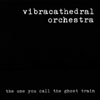 Thebetter known Vibracathedral Orchestra from the UK grace No. 010.Working with a variety of more traditional instruments, they sound abit like an outtake of the fictive 'Industrial Unplugged' Series."Oblong Two" is the far darker and heavier one of the two. It's mood isan ambiguous drift leading your ears towards amazement. The title trackleaves the impression of optimistic ignorance in midst the wasteland.This is not really my pair of shoes but I'm sure lovers of freestylepost-everything will enjoy it. These editions are numbered and featureexclusive tracks and should be available at normal 7" single prices.For more info on this extraordinary series check out
Thebetter known Vibracathedral Orchestra from the UK grace No. 010.Working with a variety of more traditional instruments, they sound abit like an outtake of the fictive 'Industrial Unplugged' Series."Oblong Two" is the far darker and heavier one of the two. It's mood isan ambiguous drift leading your ears towards amazement. The title trackleaves the impression of optimistic ignorance in midst the wasteland.This is not really my pair of shoes but I'm sure lovers of freestylepost-everything will enjoy it. These editions are numbered and featureexclusive tracks and should be available at normal 7" single prices.For more info on this extraordinary series check out 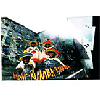 Burnt Friedman presents a smidgeon of material from Uwe Schmidt'smassive Rather Interesting back catalog for his own Nonplace label. Forthe 42 minute continuous mix, Friedman selects 14 of his favoritetracks from eight of Schmidt's many monikers (he's probably best knownas Atom? or Atom Heart). First off, I must confess that I don't own asingle Rather Interesting release. I figure this will be a good placefor me to start considering I'm an adamant collector of Freidman's workand the duo's collaborations as Flanger. Friedman's bright and spaciousaural imprint is all over the disc, either through his mixing, his ownoverdubbing or simply a like-minded approach. The main vibe is theirusual one of jazz and electronica de latina, a blurred lines blend ofsampled/programmed/played musica, sometimes at the mercy of glitchifiedhyper-editing. The rhythms vary from techno to tango and they neverstop as pianos and keys noodle, bass lines bounce and slide,electronics blip and bloop, horns and vibes dabble and faux audiencesclap in appreciation. At first it is indeed a rather interesting mix,always on the move and seamlessly sewn together, but after awhile it'sa tad too cutesy and/or bland for my taste and I start to loseinterest. What's missing is the dark beauty and black humor of some ofFriedman's solo output that I love so much. I just simply preferFriedman and Flanger's stuff over Schmidt's, simple as that. And thatgives me a sigh of relief considering the financial commitmentnecessary to keep up with Rather Interesting, not to mention all ofSchmidt's other endeavors.
Burnt Friedman presents a smidgeon of material from Uwe Schmidt'smassive Rather Interesting back catalog for his own Nonplace label. Forthe 42 minute continuous mix, Friedman selects 14 of his favoritetracks from eight of Schmidt's many monikers (he's probably best knownas Atom? or Atom Heart). First off, I must confess that I don't own asingle Rather Interesting release. I figure this will be a good placefor me to start considering I'm an adamant collector of Freidman's workand the duo's collaborations as Flanger. Friedman's bright and spaciousaural imprint is all over the disc, either through his mixing, his ownoverdubbing or simply a like-minded approach. The main vibe is theirusual one of jazz and electronica de latina, a blurred lines blend ofsampled/programmed/played musica, sometimes at the mercy of glitchifiedhyper-editing. The rhythms vary from techno to tango and they neverstop as pianos and keys noodle, bass lines bounce and slide,electronics blip and bloop, horns and vibes dabble and faux audiencesclap in appreciation. At first it is indeed a rather interesting mix,always on the move and seamlessly sewn together, but after awhile it'sa tad too cutesy and/or bland for my taste and I start to loseinterest. What's missing is the dark beauty and black humor of some ofFriedman's solo output that I love so much. I just simply preferFriedman and Flanger's stuff over Schmidt's, simple as that. And thatgives me a sigh of relief considering the financial commitmentnecessary to keep up with Rather Interesting, not to mention all ofSchmidt's other endeavors. 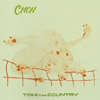 While I can truly say I have enjoyed Town and Country albums for years,I hadn't had such an incredible appreciation and awe for them until Ifinally had a chance to see them live. Friday night at the ZeitgeistGallery in Cambridge, the quartet performed a number of songs fromthis, their fourth release. While it's musically apparent that thisChicago-based drum-less multi-insturmentalist acoustic instrumentquartet have a serious history of improvisation, every song, every noteis cold-calculated and executed with the skillfullness of professionalperfection. I'm still marvelling at the amount of instruments whichcould actually fit in the tiny room. Through the night, the fourmusicians shifted around between acoustic guitars, double basses (yes,there was one song where two were played), bass clarinet, celeste,harmonium, cornet, and most impressively, a stunning set of handchimes. I couldn't keep my eyes off these things, as they had to berearranged between each song depending on which notes were used. Thesound was phenomenal, dreamlike, intoxicating and swirling and makes mevisualize the albums so much more than ever. To magically accent theevening, there was brief snowstorm outside which fit the second song onthe album, "I'm Appealing" almost perfectly, as the song is filled witha harp-like effect by rhythmically strumming what could possibly be32nd notes on two acoustic guitars. You can buy the album and get thesame effect but I highly recommend both doing that and going to see theshow if they're anywhere near you. Tour dates are posted at
While I can truly say I have enjoyed Town and Country albums for years,I hadn't had such an incredible appreciation and awe for them until Ifinally had a chance to see them live. Friday night at the ZeitgeistGallery in Cambridge, the quartet performed a number of songs fromthis, their fourth release. While it's musically apparent that thisChicago-based drum-less multi-insturmentalist acoustic instrumentquartet have a serious history of improvisation, every song, every noteis cold-calculated and executed with the skillfullness of professionalperfection. I'm still marvelling at the amount of instruments whichcould actually fit in the tiny room. Through the night, the fourmusicians shifted around between acoustic guitars, double basses (yes,there was one song where two were played), bass clarinet, celeste,harmonium, cornet, and most impressively, a stunning set of handchimes. I couldn't keep my eyes off these things, as they had to berearranged between each song depending on which notes were used. Thesound was phenomenal, dreamlike, intoxicating and swirling and makes mevisualize the albums so much more than ever. To magically accent theevening, there was brief snowstorm outside which fit the second song onthe album, "I'm Appealing" almost perfectly, as the song is filled witha harp-like effect by rhythmically strumming what could possibly be32nd notes on two acoustic guitars. You can buy the album and get thesame effect but I highly recommend both doing that and going to see theshow if they're anywhere near you. Tour dates are posted at 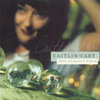 Whiskeytown is dead. Long live Whiskeytown! After the demise of North Carolina's infamous entry into the alt-country sound before their final album was released in 2001, the members went their separate ways, though at that point they really numbered only three: Mike Daly, Ryan Adams and Caitlin Cary.
Whiskeytown is dead. Long live Whiskeytown! After the demise of North Carolina's infamous entry into the alt-country sound before their final album was released in 2001, the members went their separate ways, though at that point they really numbered only three: Mike Daly, Ryan Adams and Caitlin Cary.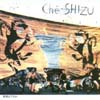 It's difficult to tell if Che-Shizu's leader, vocalist and kokyu (aChinese violin-like string instrument) player Chie Mukai, had everpicked up her instrument before the tape for this album startedrolling. Her solo kokyo improvisations (with which I am most familiar)do not rely on such conventions as tune or melody, so her atonal sawingnever sounded out of place to me before. On this, a CD reissue of herband's debut album from 1984, it appears that she either never tunedher kokyu, or else has no idea where the correct notes are, or else hadnever even seen or even considered the existance of stringedinstruments before deciding to play these songs. The tunes themselvesare downbeat Velvet Underground-like droning things with ocasional odd,sour attempts at klezmer and waltz. But Mukai's bowed monstrositysteals the show, always a bit flat or else way too sharp, and damned ifI didn't wince a dozen times within the first several minutes oflistening0. Sure, it's awful, but it's also really interesting. It's soconsistently bad that it's great. Know what I mean? I find myselflistening first in horror, then a second time to make sure I'm reallyhearing what I think I'm hearing (christ, she really IS off for theentire damn album!), then again because I like the songs and thebizarreness has worn off. Speaking of the Velvets, Mukai's voice has adeadpan quality that brings Nico (especially "The Marble Index") tomind. Her band's accompaniment is appropriately spare and mournful,serving mostly as a frame for the kokyu and voice; a determinedly na?vequality reigns, shocking in its spare directness. For more information,check
It's difficult to tell if Che-Shizu's leader, vocalist and kokyu (aChinese violin-like string instrument) player Chie Mukai, had everpicked up her instrument before the tape for this album startedrolling. Her solo kokyo improvisations (with which I am most familiar)do not rely on such conventions as tune or melody, so her atonal sawingnever sounded out of place to me before. On this, a CD reissue of herband's debut album from 1984, it appears that she either never tunedher kokyu, or else has no idea where the correct notes are, or else hadnever even seen or even considered the existance of stringedinstruments before deciding to play these songs. The tunes themselvesare downbeat Velvet Underground-like droning things with ocasional odd,sour attempts at klezmer and waltz. But Mukai's bowed monstrositysteals the show, always a bit flat or else way too sharp, and damned ifI didn't wince a dozen times within the first several minutes oflistening0. Sure, it's awful, but it's also really interesting. It's soconsistently bad that it's great. Know what I mean? I find myselflistening first in horror, then a second time to make sure I'm reallyhearing what I think I'm hearing (christ, she really IS off for theentire damn album!), then again because I like the songs and thebizarreness has worn off. Speaking of the Velvets, Mukai's voice has adeadpan quality that brings Nico (especially "The Marble Index") tomind. Her band's accompaniment is appropriately spare and mournful,serving mostly as a frame for the kokyu and voice; a determinedly na?vequality reigns, shocking in its spare directness. For more information,check 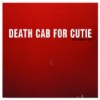 For those who missed the limited release of Death Cab For Cutie's lastrelease "The Photo Album," DCFC have released the EP that came withthat release separately, calling it "The Stability EP." It's ultimatelyheavier material than that on the last LP, as these songs could almostcrush the listener with their subject matter and slow, driven music.The center piece is "Stability," a near 13-minute DCFC epic that couldalmost be described as "Death Cab For Post-Rock." Languid, lush,slowcore galore, the track is easily the closest the band will everapproach that genre. The track finishes with over 6 minutes of greatguitar melodies, a steady drumbeat, and keyboard swells and pulses withno clear vocals to speak of. Of course, there are vocals by BenjaminGibbard at the top of the track, as well as piano, and a fewMogwai-like edits. The second track is a Bjork cover, and a greateffort by DCFC, especially the hyper drumwork. DCFC are known for theirodd cover choices live, as an MP3 search even turns up a cover of theEurythmics classic "Here Comes the Rain Again." They pull off thisBjork classic with gusto and all sincerity, making it the highpoint ofthe release. "20th Century Towers" is classic DCFC, just a lot slower:meek vocals by Gibbard, intertwined guitar and bass, and just went youthink it will give up the ghost and rock out, Gibbard holds it all in.The only complaint is the crowd vocal towards the track's final third.I would have preferred to hear Gibbard solo or double-tracked, not whatyou expect in a drunken English pub crowd. All in all, not a bad threetracks if you got it with the record, but I don't know if I'd spend $10on it in the stores.
For those who missed the limited release of Death Cab For Cutie's lastrelease "The Photo Album," DCFC have released the EP that came withthat release separately, calling it "The Stability EP." It's ultimatelyheavier material than that on the last LP, as these songs could almostcrush the listener with their subject matter and slow, driven music.The center piece is "Stability," a near 13-minute DCFC epic that couldalmost be described as "Death Cab For Post-Rock." Languid, lush,slowcore galore, the track is easily the closest the band will everapproach that genre. The track finishes with over 6 minutes of greatguitar melodies, a steady drumbeat, and keyboard swells and pulses withno clear vocals to speak of. Of course, there are vocals by BenjaminGibbard at the top of the track, as well as piano, and a fewMogwai-like edits. The second track is a Bjork cover, and a greateffort by DCFC, especially the hyper drumwork. DCFC are known for theirodd cover choices live, as an MP3 search even turns up a cover of theEurythmics classic "Here Comes the Rain Again." They pull off thisBjork classic with gusto and all sincerity, making it the highpoint ofthe release. "20th Century Towers" is classic DCFC, just a lot slower:meek vocals by Gibbard, intertwined guitar and bass, and just went youthink it will give up the ghost and rock out, Gibbard holds it all in.The only complaint is the crowd vocal towards the track's final third.I would have preferred to hear Gibbard solo or double-tracked, not whatyou expect in a drunken English pub crowd. All in all, not a bad threetracks if you got it with the record, but I don't know if I'd spend $10on it in the stores. 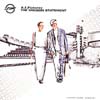 I'm rarely disappointed by Novamute releases. Usually, they have enough intelligent and interesting tracks to keep me interested and sometimes produce modern classics (Speedy J's 'A Shocking Hobby' being the perfect example of the latter). 'The Mission Statement', S.I. Futures' debut album for the label, is no exception to the rule, but also no significant landmark in the Novamute catalog.
I'm rarely disappointed by Novamute releases. Usually, they have enough intelligent and interesting tracks to keep me interested and sometimes produce modern classics (Speedy J's 'A Shocking Hobby' being the perfect example of the latter). 'The Mission Statement', S.I. Futures' debut album for the label, is no exception to the rule, but also no significant landmark in the Novamute catalog.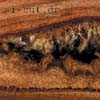 The band with the least pronoucable name since a:GRUMH... is actuallyone Douglas Benford (the ".db" is his initials), who has left drum n'bass behind to explore sunny dub rhythms on his latest CD for the fineDIY-techno Bip-Hop label. The tunes do not attempt perfect replicationof the Jamaican style, as does Twight Circus Dub Sound System or TinoCorp. Instead, Benford merely references the missing pieces andecho-laden beats of dub to turn in a pleasant, if light and airy, setof predominantly instrumental (save a sample here and there) tunes. Thefirst few songs are as enjoyable as this sort of thing can be, but theend of the set turns a bit sweet for my tastes. The best work of KingTubby and Lee Perry had an underlying heaviness and darkness thatBenford does not appear particularly interested in. The beginning of"Enthusiaist" contains some wonderful sections (particularly in theopening cut "Contaminile 2") which really stretch out and dig into thewarm expansiveness that dub techniques can produce. The album getspoppier as it goes on, though, and becomes progressively lessinteresting.
The band with the least pronoucable name since a:GRUMH... is actuallyone Douglas Benford (the ".db" is his initials), who has left drum n'bass behind to explore sunny dub rhythms on his latest CD for the fineDIY-techno Bip-Hop label. The tunes do not attempt perfect replicationof the Jamaican style, as does Twight Circus Dub Sound System or TinoCorp. Instead, Benford merely references the missing pieces andecho-laden beats of dub to turn in a pleasant, if light and airy, setof predominantly instrumental (save a sample here and there) tunes. Thefirst few songs are as enjoyable as this sort of thing can be, but theend of the set turns a bit sweet for my tastes. The best work of KingTubby and Lee Perry had an underlying heaviness and darkness thatBenford does not appear particularly interested in. The beginning of"Enthusiaist" contains some wonderful sections (particularly in theopening cut "Contaminile 2") which really stretch out and dig into thewarm expansiveness that dub techniques can produce. The album getspoppier as it goes on, though, and becomes progressively lessinteresting.
